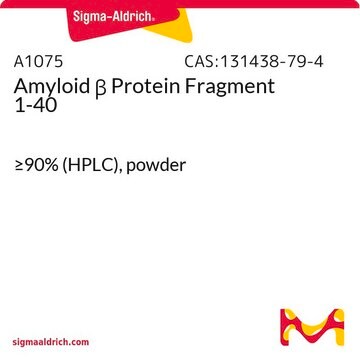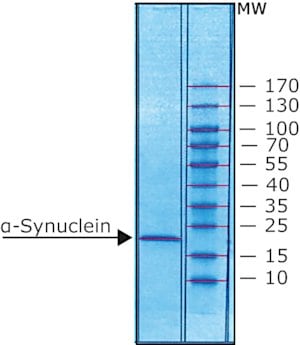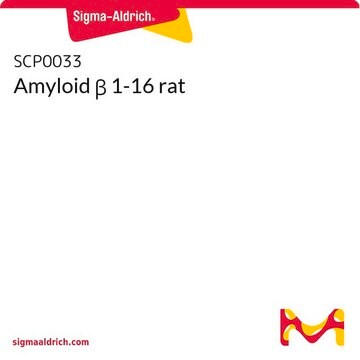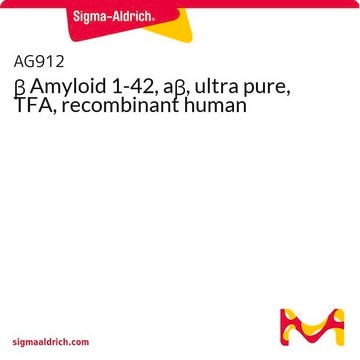추천 제품
분석
≥90% (HPLC)
형태
lyophilized
구성
Peptide Content, ≥75%
저장 조건
protect from light
저장 온도
−20°C
Amino Acid Sequence
Asp-Ala-Glu-Phe-Gly-His-Asp-Ser-Gly-Phe-Glu-Val-Arg-His-Gln-Lys-Leu-Val-Phe-Phe-Ala-Glu-Asp-Val-Gly-Ser-Asn-Lys-Gly-Ala-Ile-Ile-Gly-Leu-Met-Val-Gly-Gly-Val-Val-Ile-Ala
일반 설명
Amyloid β (Aβ) 1-42 is the major Aβ species in the amyloid plaques that develop in the case of Alzheimer′s disease (AD). It has a cross-β structure with parallel, in-register β-sheets.
애플리케이션
Amyloid β 1-42 rat has been used as an amyloid β (Aβ) oligomer in intracerebroventricular (ICV) injection/intra-hippocampal infusion to establish the Alzheimer′s disease (AD) model in rat.
생화학적/생리학적 작용
Amyloid β 1-42 forms amyloid fibrils more readily compared to Aβ(1–40), in vitro. Aβ1-42 injections are known to cause brain dysfunction indicating learning and memory deficits. Amyloid β (Aβ) refers to peptides derived from amyloid precursor protein that vary in length from 37–43 amino acids. Aβ(s) peptides, their peptide fragments, and mutated fragments are used to study a wide range of metabolic and regulatory functions including activation of kinases, regulation of cholesterol transport, function as a transcription factor, and regulators of inflammation. Aβ(s) peptides and their peptide fragments are also used to study oxidative stress, metal binding, and mechanisms of protein cross-linking in the context of diseases such as Alzheimer′s disease and neurodegeneration.
Storage Class Code
11 - Combustible Solids
WGK
WGK 3
Flash Point (°F)
Not applicable
Flash Point (°C)
Not applicable
시험 성적서(COA)
제품의 로트/배치 번호를 입력하여 시험 성적서(COA)을 검색하십시오. 로트 및 배치 번호는 제품 라벨에 있는 ‘로트’ 또는 ‘배치’라는 용어 뒤에서 찾을 수 있습니다.
이미 열람한 고객
Jing Wang et al.
Molecular medicine reports, 23(6) (2021-04-22)
Ginkgolide B (GB), the diterpenoid lactone compound isolated from the extracts of Ginkgo biloba leaves, significantly improves cognitive impairment, but its potential pharmacological effect on astrocytes induced by β‑amyloid (Aβ)1‑42 remains to be elucidated. The present study aimed to investigate the
Enes Akyuz et al.
Biomedicines, 8(3) (2020-03-19)
Alzheimer's disease (AD) is a progressive neurodegenerative disorder with a complex etiology and characterized by cognitive deficits and memory loss. The pathogenesis of AD is not yet completely elucidated, and no curative treatment is currently available. Inwardly rectifying potassium (Kir)
Volodymyr A Yavorsky et al.
Frontiers in cellular neuroscience, 17, 1132092-1132092 (2023-05-01)
One of the signs of Alzheimer's disease (AD) is the formation of β-amyloid plaques, which ultimately lead to the dysfunction of neurons with subsequent neurodegeneration. Although extensive researches have been conducted on the effects of different amyloid conformations such as
Raheleh Farahzadi et al.
ACS chemical neuroscience, 11(10), 1424-1435 (2020-04-21)
Mesenchymal stem cells (MSCs) are of particular interest because of their potential in regenerative medicine. Stem cell-based therapies cast a new hope for neurodegenerative disease treatment as a regeneration strategy, including treatment for Alzheimer's disease (AD). A multitude of cytokines
Ruo-Meng Li et al.
Neural regeneration research, 18(6), 1347-1353 (2022-12-02)
Previous studies have shown that fibroblast growth factor 13 is downregulated in the brain of both Alzheimer's disease mouse models and patients, and that it plays a vital role in the learning and memory. However, the underlying mechanisms of fibroblast
자사의 과학자팀은 생명 과학, 재료 과학, 화학 합성, 크로마토그래피, 분석 및 기타 많은 영역을 포함한 모든 과학 분야에 경험이 있습니다..
고객지원팀으로 연락바랍니다.




![[Gly22]-Amyloid β 1-42 Arctic human](/deepweb/assets/sigmaaldrich/product/images/222/254/58bfa018-4218-48a8-957d-f4d67366a533/640/58bfa018-4218-48a8-957d-f4d67366a533.jpg)






![[Ala28]-Amyloid β 25-35 ≥95% (HPLC)](/deepweb/assets/sigmaaldrich/product/images/306/938/dd9f7c72-cfca-4ea3-8e10-a7a2a7994639/640/dd9f7c72-cfca-4ea3-8e10-a7a2a7994639.jpg)